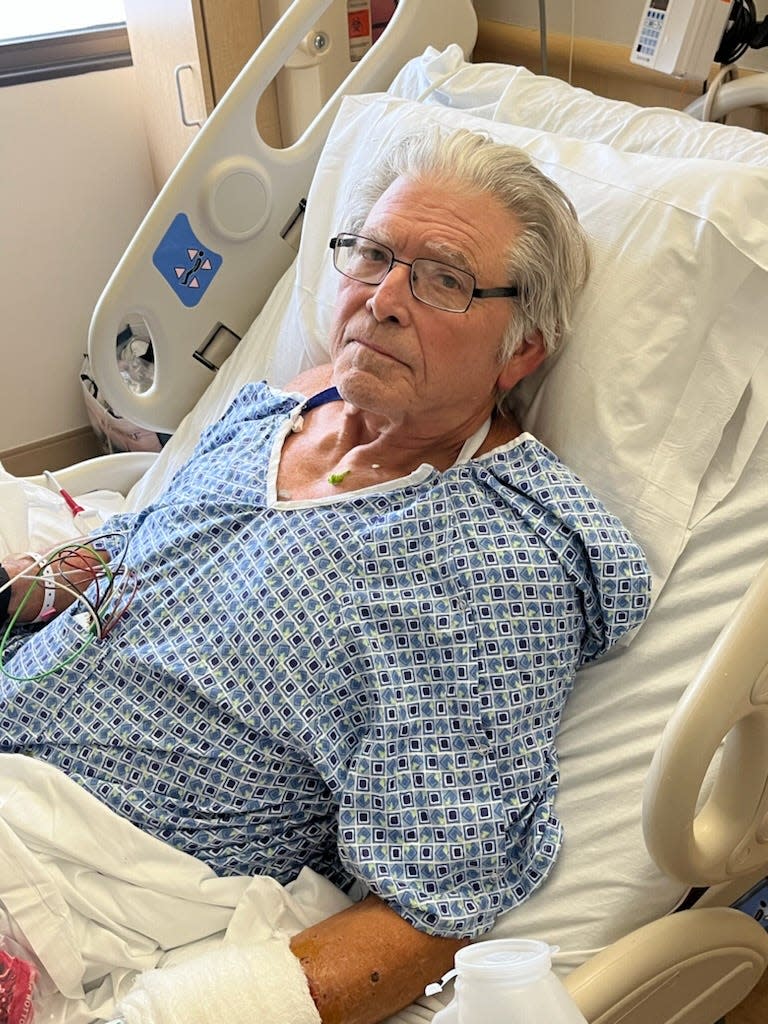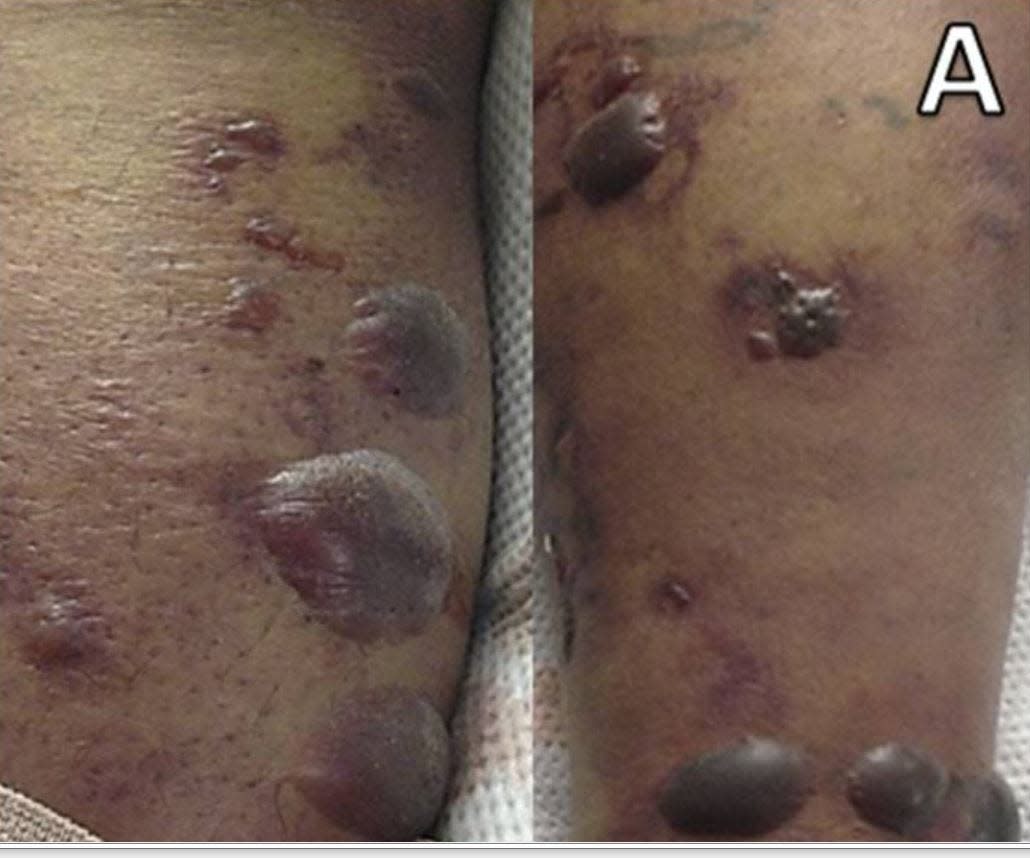Hurricane Ian and Vibrio bacteria: Storm spiked the microbe, Florida researchers found
It may be rare, but Vibrio vulnificus is nothing to mess around with.
Just ask Terry Brennen, a Cape Coral veteran who got a nasty case of the stuff courtesy of Hurricane Ian more than a year ago. All it took was stormwater getting into his scraped leg as he was cleaning up after the storm.
New research suggests that what Brennen experienced – the threat of amputation, a year of painful treatments, and untold anxiety – will become more common as a changing climate fosters more powerful storms like Ian, after which Lee County hit an all-time record number of cases. It also showed the microbes that caused his woes have genes that can help them resist antibiotics.

The paper, featuring work of scientists from the University of Florida and the University of Maryland, appeared in the American Society for Microbiology’s journal, mBio. The study analyzed water samples from three offshore Lee County sites near Pine Island, satellite data and genome sequencing. It looked at bacteria in the Vibrio genus, a group that includes about a dozen species that can cause disease (some even glow in the dark).
Vibrio vulnificus (don't call it flesh-eating) cousin of cholera
Perhaps best-known Vibrio worldwide is cholera, but in Southwest Florida the one that’s grabbed the most dramatic headlines is V. vulnificus, which can cause necrotizing fasciitis, commonly – though incorrectly – called flesh-eating disease. It can enter the body through a break in the skin as minor-seeming as a scrape or people can swallow the bacteria, often in contaminated seafood.
Physician and co-author Norman Beatty, a UF assistant professor who specializes in infectious diseases, notes the organism occurs naturally in brackish water, where fresh and salt meet, like the Caloosahatchee and its estuary. Though it's generally not a problem for people with robust immune systems, it can be quickly life-threatening for those without them.
That's not to say healthy folks should throw caution to the wind, Beatty says. "I have seen cases with no risk factors."
Key takeaways from the paper, titled "Genomic diversity of Vibrio spp. and metagenomic analysis of pathogens in Florida Gulf coastal waters following Hurricane Ian":
▪ Climate change increases infection risk by increasing potential for exposure, as severe storms push water into new places, like Terry Brennen's Cape Coral driveway.
▪ Ian caused a spike in the bacteria, which showed up in nearly every water specimen. "Almost all the samples had a positive hit and this was surprising to us," said researcher and co-author Antarpreet Jutla, a UF associate professor in the department of environmental engineering sciences.
▪ Warming waters also can help the bacteria expand its range northward.
▪ The bacteria can fight back. "Genes coding for antimicrobial resistance ... were found at all stations," the paper said. That means common antibiotics may not be as effective, though in advanced cases removal of the damaged tissue is the rule, says Beatty.
With Vibrio, vigilance is critical
One promising research avenue is the use of satellite imagery to detect Vibrio from above, something already being done with the species that causes cholera, with accuracy between 80 and 90%, Jutla says.
The technology is not yet as refined with vulnificus, but it's getting there. "We can basically determine the condition under which ecology of water can determine likelihood – though we're not there at a (species) level yet." Ultimately, it could be used to create a forecasting system to advise people when to be cautious.
'If we can save one life, we’re happy," he said.
Smashing a grim record: Why the record number of 'flesh-eating' bacteria cases? Health department blames Hurricane Ian
Because time is critical with a Vibrio infection, Beatty hopes this study and others that follow will raise awareness for clinicians and patients alike.
"Within hours, one may start seeing bullae (fluid-filled blisters) develop at the site, which is worrisome and should result in finding emergent medical attention," Beatty said.
He's seen infections happen after people cut themselves on oyster shells, nicked their leg in a boat, or in one case, ate contaminated shrimp tacos from a roadside stand in Arizona. Conditions like liver disease, chemotherapy or diabetes can make people more vulnerable, he says.

"It's still a rare infection but because it’s life threatening and mortality can be as high as 30 to 40%, "we need awareness," he said. "I’m a Floridian. I don’t want people staying away from beaches, but if you have an open would, consider not going in the water, and if you get a wound, exit the water then watch it closely ... Sadly, I have seen cases of wound infection develop very rapidly, like in hours."
'If you have a scratch, you're risking your life'
More than a year after his infection, Brennen's wife Carlene sees his ordeal as a cautionary tale.
Necrotizing fasciitis was the last thing on his mind as the retired fundraising executive for WGCU worked to gather downed limbs and palm fronds following Ian's two feet of storm surge.
The work left Terry’s legs cut and nicked, so Carlene put antibiotic ointment and bandages on him. At first, he waved her off. “You know how guys are," she told The News-Press at the time. "He was saying, ‘Oh, I’m good’ and he was still out there raking up this crap.“
The next day, Terry was oddly warm. “I put my hand to his leg and it felt like fever,” Carlene said.
By the third morning, they knew something was really wrong. He could hardly walk. “I said, ‘Terry, you’re going to the hospital.’”
What followed was a series of operations to remove the damaged tissue, skin grafts to fill in the gaps, hospital stays, rehab stints and ongoing wound care.
"The flesh eating part is gone now, but because he’s diabetic it’s taking a really long time to heal," Carlene said.
With the help of compression bandages and imported dressings, he finally seems to have turned a corner, she says, but the fight continues, she says. Over the past year, she's become something of a Vibrio safety evangelist. "If you have a scratch," she says. "you’re risking your life by walking in the water."
This article originally appeared on Fort Myers News-Press: Flesh-destroying Vibrio: Study says to expect more as storms get worse
